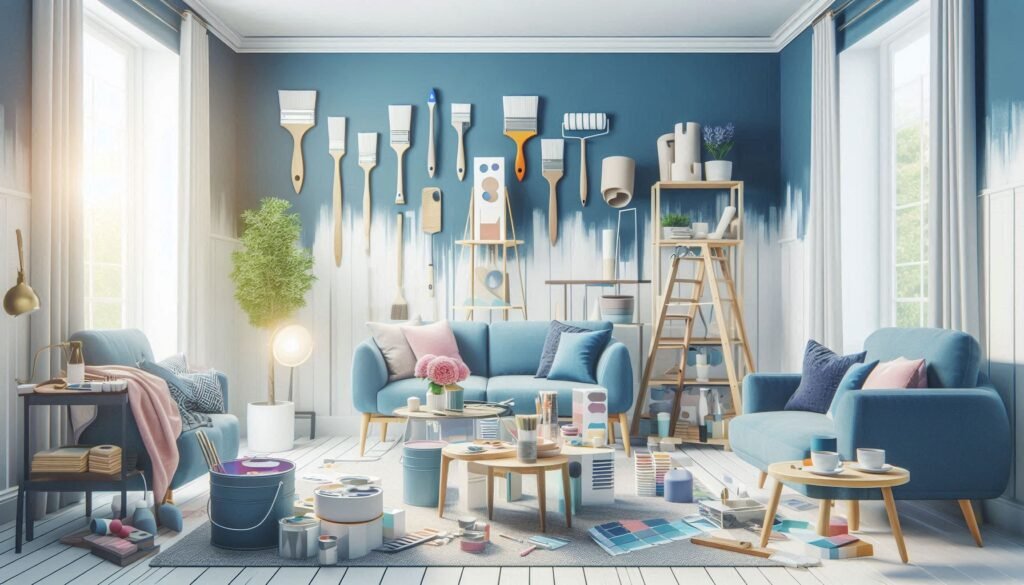Whether you’re looking to refresh a single wall or completely overhaul the look of your space, painting a room can be a rewarding and budget-friendly home improvement project. In this guide, we’ll walk you through the essential tools, prep work, techniques, and color selection tips to help you paint like a pro—even if it’s your first time.
Painting a room is one of the quickest and most cost-effective ways to refresh your living space. But if you’ve never tackled a painting project before, the idea can seem intimidating. Don’t worry—this guide will help you navigate the process, from selecting the right paint to finishing your project with a smooth and professional-looking result. Ready to get started? Let’s dive in!

Essential Tools You’ll Need
Before you start, it’s important to gather all the necessary tools. Having the right equipment can make a world of difference in the quality and ease of your paint job.
1. Paint Brushes and Rollers
- Brushes: A 2- to 3-inch angled brush is perfect for edges, trim, and corners. Use a high-quality synthetic brush for water-based paints.
- Rollers: A roller with a medium nap (3/8 to 1/2 inch) is ideal for smooth to semi-smooth surfaces. For textured walls, opt for a thicker nap.
2. Painter’s Tape
Painter’s tape is essential for achieving clean, sharp lines around the edges of your walls, trim, and ceiling. Choose a high-quality tape that won’t peel off your paint when removed.
3. Drop Cloths or Plastic Sheets
Protect your floors, furniture, and other surfaces from paint splatters by covering them with drop cloths or plastic sheets. These are especially useful for larger areas.
4. Paint Tray and Liners
A paint tray will hold your paint while you roll it onto the walls. Liners make cleanup easier, especially when using different colors or types of paint.
5. Paint Can Opener and Stir Sticks
You’ll need a paint can opener to pry open the cans, and stir sticks to ensure your paint is well-mixed and smooth.
6. Extension Pole (for Rollers)
If you’re painting high walls or ceilings, an extension pole for your roller will help you reach those hard-to-reach places without using a ladder.
Prep Work: The Key to a Perfect Paint Job
Preparation is essential to achieving a professional-looking finish. A little extra time spent on prep work will go a long way.
1. Clear the Room
Start by removing all furniture or moving it to the center of the room and covering it with plastic or drop cloths. If you’re painting trim or baseboards, cover the floor to avoid splatters.
2. Clean the Walls
Dust and dirt can prevent paint from adhering properly. Use a damp cloth to wipe down the walls and remove any debris. For stubborn stains, a mild cleaning solution will do the trick.
3. Repair Any Imperfections
Check the walls for any holes or cracks. Use spackling paste to fill in small holes and sand them smooth once dry. Larger holes may require a patching compound.
4. Apply Painter’s Tape
Tape along edges where the wall meets the trim, ceiling, or baseboards. Press the tape down firmly to ensure no paint seeps through. Be careful when taping around outlets and switches.
5. Prime the Walls
If you’re painting over a dark color or stained walls, it’s a good idea to apply a primer before the topcoat. Primer helps the paint adhere better and ensures even coverage.
Choosing the Right Paint Color
Selecting the perfect color is one of the most exciting parts of painting, but it can also be overwhelming. Here are some tips to help you choose wisely:
1. Consider Room Function
Think about how you want the room to feel. For example:
- Living rooms and bedrooms: Soft neutrals, blues, or greens for a relaxing, cozy vibe.
- Kitchens and dining rooms: Warm tones like yellows, oranges, or reds can stimulate appetite and conversation.
- Home offices: Calm, neutral colors or light tones like soft grays or pastels help with focus and concentration.
2. Test Sample Colors
Always test a small swatch of the paint color on your wall before committing to the entire room. Look at the color at different times of the day to see how it changes with natural light.
3. Consider Paint Finishes
The finish affects both the look and durability of the paint:
- Matte: Ideal for hiding imperfections, but harder to clean.
- Eggshell: Slightly shiny, good for most rooms and easier to clean than matte.
- Satin or Semi-Gloss: Perfect for high-traffic areas like kitchens or bathrooms.
Painting Techniques for a Smooth Finish
Now that you’ve prepped your space and chosen your paint, it’s time to start painting! Here are some techniques for achieving the best results.
1. Start with the Edges
Use a brush to cut in along the edges of the wall. This means painting around the corners, along the trim, and near the ceiling. Take your time and use painter’s tape to create a clean line.
2. Use a Roller for Large Areas
Once the edges are done, use a roller to cover the larger areas. Start from the top and work your way down to avoid streaking. Use long, even strokes to apply the paint, and don’t overload the roller with too much paint at once.
3. Apply Multiple Coats
Most rooms will require at least two coats of paint for complete coverage. Be sure to let the first coat dry completely before applying the second.
4. Blend the Edges
If you’re painting with multiple colors or sections, make sure the edges between them blend seamlessly. Use a technique called “feathering,” where you roll lightly over the edge to avoid visible lines.
5. Clean Your Brushes and Rollers
Clean your brushes and rollers as soon as you’re done to keep them in good condition for future projects. Wash them with warm water and soap if you’re using water-based paints, or with the appropriate solvent for oil-based paints.
Conclusion
Painting a room may seem like a big project, but with the right tools, prep work, and techniques, you can achieve a professional-quality finish. By following this beginner’s guide, you’ll be able to tackle your painting project with confidence, creating a fresh, vibrant space that enhances your home.
Call to Action:
LEARN POWERFUL DIGITAL SKILLS. ATTEND FREE MASTERCLASS NOW!
Click here to join the masterclass!
Related Blog Posts
10 Budget-Friendly Room Makeover
How to Organize Your Home Like a Pro
15 Creative Storage Solutions for Small Spaces
A Beginner’s Guide to Painting a Room
How to Create a Cozy Home Office
Simple DIY Landscaping Projects
10 Must-Know Tips for Organizing Your Kitchen





